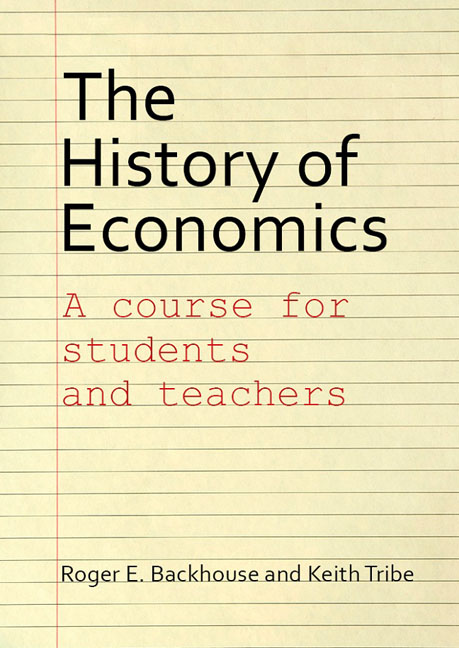Book contents
- Frontmatter
- Contents
- Introduction
- Lecture 1 Commerce, Wealth and Power: The Disputed Foundations of the Strength of a Nation
- Lecture 2 Natural Order, Physiocracy and Reform
- Lecture 3 Adam Smith I: Outline of a Project
- Lecture 4 Adam Smith II: The Two Texts
- Lecture 5 The Political Economy of Malthus and Ricardo
- Lecture 6 Political Economy in Continental Europe and the United States
- Lecture 7 Political Economy, Philosophic Radicalism and John Stuart Mill
- Lecture 8 Popular Political Economy: List, Carey, Bastiat and George
- Lecture 9 Radical Political Economy: Marx and His Sources
- Lecture 10 Marginalism and Subjectivism: Jevons and Edgeworth
- Lecture 11 From Political Economy to Economics
- Lecture 12 Alfred Marshall’s Project
- Lecture 13 Markets and Welfare after Marshall
- Lecture 14 Monetary Economics
- Lecture 15 The Rise of Mathematical Economics
- Lecture 16 Robbins’s Essay and the Definition of Economics
- Lecture 17 John Maynard Keynes
- Lecture 18 Quantitative Economics
- Lecture 19 The Keynesian Revolution
- Lecture 20 Modern Macroeconomics
- Lecture 21 Inflation and the Phillips Curve
- Lecture 22 Popular Economics
- Lecture 23 Economics and Policy
- Lecture 24 Ideology and Place
- Index
Lecture 21 - Inflation and the Phillips Curve
Published online by Cambridge University Press: 09 August 2023
- Frontmatter
- Contents
- Introduction
- Lecture 1 Commerce, Wealth and Power: The Disputed Foundations of the Strength of a Nation
- Lecture 2 Natural Order, Physiocracy and Reform
- Lecture 3 Adam Smith I: Outline of a Project
- Lecture 4 Adam Smith II: The Two Texts
- Lecture 5 The Political Economy of Malthus and Ricardo
- Lecture 6 Political Economy in Continental Europe and the United States
- Lecture 7 Political Economy, Philosophic Radicalism and John Stuart Mill
- Lecture 8 Popular Political Economy: List, Carey, Bastiat and George
- Lecture 9 Radical Political Economy: Marx and His Sources
- Lecture 10 Marginalism and Subjectivism: Jevons and Edgeworth
- Lecture 11 From Political Economy to Economics
- Lecture 12 Alfred Marshall’s Project
- Lecture 13 Markets and Welfare after Marshall
- Lecture 14 Monetary Economics
- Lecture 15 The Rise of Mathematical Economics
- Lecture 16 Robbins’s Essay and the Definition of Economics
- Lecture 17 John Maynard Keynes
- Lecture 18 Quantitative Economics
- Lecture 19 The Keynesian Revolution
- Lecture 20 Modern Macroeconomics
- Lecture 21 Inflation and the Phillips Curve
- Lecture 22 Popular Economics
- Lecture 23 Economics and Policy
- Lecture 24 Ideology and Place
- Index
Summary
Aims of the lecture
1. To show how reading what economists actually wrote can sometimes be enough to challenge a history that virtually all economists accept. The fact that economists are near unanimous in what they know about the history of their discipline does not necessarily mean that their history is correct.
2. To tell the story of how economists have analysed the relationship between inflation and unemployment.
3. To speculate on how and why erroneous versions of the history became established.
This lecture is a lesson in the importance of reading original texts carefully and not assuming that commentators, who may not have read the papers they discuss, are necessarily correct.
Bibliography
This lecture is essentially based on one book: J. Forder, Macroeconomics and the Phillips Curve Myth (Oxford: Oxford University Press, 2014). Some of the material can be found in articles Forder wrote en route to the book, and an article on incomes policy serves as a reminder of how differently labour market problems were conceived from the 1950s to the 1970s: J. Forder, “Friedman’s Nobel Lecture and the Phillips Curve Myth”, Journal of the History of Economic Thought 32:3 (2010), 329–48; J. Forder, “The Historical Place of the ‘Friedman–Phelps’ Expectations Critique”, European Journal of the History of Economic Thought 17:3 (2010), 493–511; R. E. Backhouse and J. Forder, “Rationalizing Incomes Policy in Britain, 1948–1979”, History of Economic Thought and Policy 1:1 (2013), 17–35.
The lecture focuses on three papers: A. W. Phillips, “The Relation Between Unemployment and the Rate of Change of Money Wage Rates in the United Kingdom, 1861–1957”, Economica 25:100 (1958), 283–99; P. A. Samuelson and R. M. Solow, “Analytical Aspects of Anti-Inflation Policy”, American Economic Review 50:2 (1960), 177–94; and M. Friedman, “The Role of Monetary Policy”, American Economic Review 58:1 (1968), 1–17.
K. D. Hoover’s “The Genesis of Samuelson and Solow’s Price-Inflation Phillips Curve”, History of Economics Review 61 (2015), 1–16, provides a detailed reconstruction of the way in which Samuelson and Solow calculated the Phillips curve in their paper.
- Type
- Chapter
- Information
- The History of EconomicsA Course for Students and Teachers, pp. 319 - 330Publisher: Agenda PublishingPrint publication year: 2017



